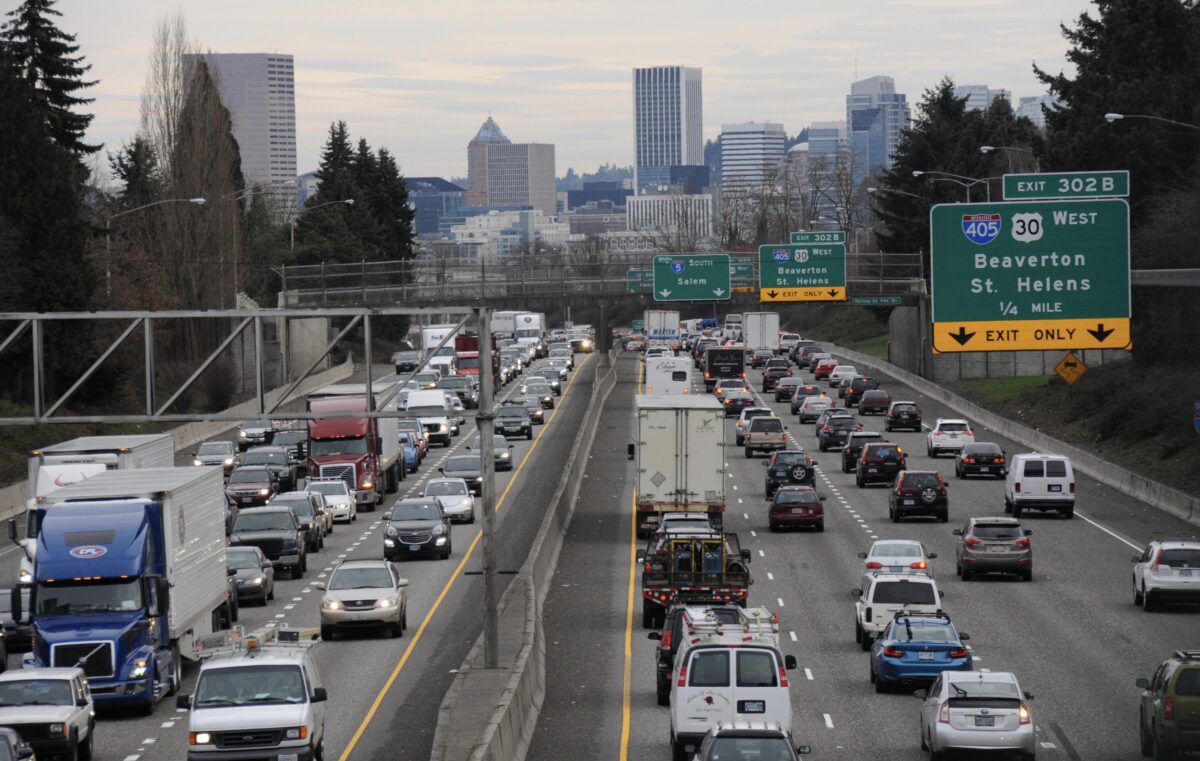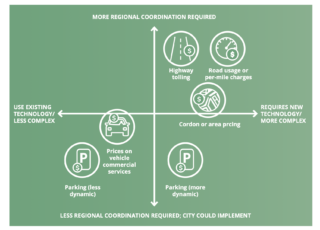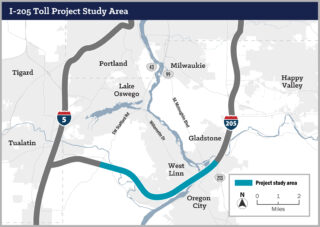
(Photo: Jonathan Maus/BikePortland)
Following the lead of other cities around the globe, the three major transportation agencies in the Portland region want to find new ways to charge for use of the roadway.
The Oregon Department of Transportation (ODOT) is working to implement tolling on Portland-area freeways, the Portland Bureau of Transportation (PBOT) recently adopted a set of recommendations from their Pricing Options for Equitable Mobility (POEM) plan that call for a variety of ways to encourage less driving. And Metro, Portland’s regional planning authority, has been working on ways to incorporate congestion management into the 2023 update of the Regional Transportation Plan.
Given that all three agencies are simultaneously talking about congestion pricing and tolling, we wanted to help you get a handle on each of their approaches and share an update on where things stand.
Metro’s Regional Congestion Pricing Study released back in July, explained how all three agencies are working together: “Metro, ODOT, and the City of Portland are all working on projects that consider ways to price transportation to address challenges related to equity, climate change, congestion, and safety. Each agency makes decisions for different parts of our region’s transportation system. Each has separate projects underway to help address issues specific to those geographies. The three agencies are coordinating their efforts to leverage each other’s work, learn from one another and share findings.”
Metro’s report looked at four different ways to reduce congestion: A VMT charge, which charges people driving per mile in the metropolitan planning area; a cordon method which would charge people driving in a certain area; increased parking fines and roadway charges specific to highways. These methods showed a variety of outcomes, but all were found to be helpful in reducing congestion to some degree. This report also dug into the equity implications that these fees could have. Metro’s report will be a roadmap for policymakers developing the 2023 RTP with the expectation that this updated plan will include its recommendations.
Just this week Metro Council showed it has some leverage, making congestion pricing on the Interstate Bridge Replacement (IBR) project a condition of providing $36 million to continue funding this project. Metro Council ultimately voted 5-1 to support the project, but the agency also adopted a Values, Outcomes and Actions statement with an amendment from a coalition of advocacy groups that requires ODOT to analyze how vehicle miles traveled (VMT) can be reduced by using congestion pricing (and other tools).
Advertisement
ODOT
ODOT is pursuing two congestion pricing projects: the Regional Mobility Pricing Project (RMPP) and the I-205 Toll Project.
The RMPP and the I-205 toll project both include congestion pricing on I-205. However, the I-205 project will cover the seven-mile stretch of the freeway between Stafford Road and OR 213, while the RMPP will toll the rest of I-205 — from south of the Glenn Jackson Bridge that connects Oregon and Washington across the Columbia River to where it meets I-5 — and I-5 from Interstate Bridge at the Columbia River to the Boone Bridge in Wilsonville.
ODOT says an environmental assessment for the I-205 toll project will be completed and open for public review and comment this spring, and the earliest tolling could begin is 2024. Environmental review for the RMPP on the other hand, won’t begin until next year, and tolling could begin by 2025 or 2026.
In its explanation for these tolling programs, ODOT says “tolling is a necessary tool to fix our transportation system” by helping manage traffic congestion.
Revenue from ODOT’s tolling programs would help pay for controversial highway expansions on I-5 and I-205. Tolling programs (also called congestion pricing) in cities like London have used revenue from drivers to fund new public transit projects. This would be the case in New York, too. If ODOT puts all its toll revenue straight back into highway projects, they’ll continue to face stiff rebuke from activists.
Advertisement
PBOT

Back in October, we reported on the adoption of PBOT’s Pricing Options for Equitable Mobility (POEM) plan. That plan includes a set of recommendations on how to use pricing of car use to increase PBOT revenue. It also gave PBOT a nine-month window to delve deeper into the recommendations and return with an action plan to implement them (which should be around July 2022).
The POEM report looked at both near-term and relatively simple steps to take a flexible commuter benefit program from employers or a parking surcharge, as well as more complicated policies like cordon zones downtown that drivers would have to pay to enter.
PBOT will also play a big role in whatever ODOT wants to do with area freeway tolling. “ODOT is proceeding with the environmental review process of tolling on interstate highways,” the report says. “And the City remains engaged as a key stakeholder.”
We’ll be closely following how ODOT, Metro and PBOT will work together to implement policies recommended in these plans to reduce traffic congestion in an equitable way. When combined, the strategies could have a big impact on how people in the Portland metro area get around.





